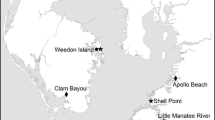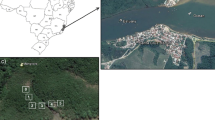Abstract
Measurements of aboveground and belowground biomass allocations are important for characterization of structure and function in marsh ecosystems as various processes such as carbon sequestration, gas transport, nutrient cycling, and ecosystem resilience are affected by these allocations. We measured aboveground and belowground biomass, root and rhizome characteristics, leaf area index (LAI), and carbon to nitrogen (C/N) ratio of various tissues of four tidal marsh species in New Jersey by harvesting biomass during peak growing season. The aboveground biomasses for Spartina patens, S. alterniflora, Phragmites australis, and Distichlis spicata were 2.3, 2.2, 1.7 and 1.2 kg m−2, respectively. The ratio of belowground to aboveground biomass for S. alterniflora and D. spicata, harvested from a recently restored wetland were lower than in previous studies. LAI for S. alterniflora, D. spicata, P. australis, and S. patens were 8.4, 6.8, 4.8 and 3.7 m2 m−2, respectively. Diameter of rhizome and root, number of primary roots per node, root surface area to volume ratio, and C/N of various tissues varied with species. The measured above- and belowground biometric traits are crucial for a better understanding of carbon dynamics, and modeling greenhouse gas transport in marsh ecosystems.




Similar content being viewed by others
References
Beckett PM, Armstrong W, Armstrong J (2001) Mathematical modelling of methane transport by Phragmites: the potential for diffusion within the roots and rhizosphere. Aquat Bot 69:293–312
Chanton JP, Martens CS, Kelley CA (1989) Gas transport from methane-saturated, tidal freshwater and wetland sediments. Limnol Oceanogr 34:807–819
Chmura GL, Anisfeld SC, Cahoon DR et al (2003) Global carbon sequestration in tidal, saline wetland soils. Glob Biogeochem Cycles 17:1111
Dai Y, Dickinson RE, Wang Y (2004) A two-big-leaf model for canopy temperature, photosynthesis, and stomatal conductance. J Clim 17:2281–2299
Darby FA, Turner RE (2008) Below- and aboveground Spartina alterniflora production in a Louisiana salt marsh. Estuar Coasts 31:223–231
Davey E, Wigand C, Johnson R et al (2011) Use of computed tomography imaging for quantifying coarse roots, rhizomes, peat, and particle densities in marsh soils. Ecol Appl 21:2156–2171
de Neiff AP, Neiff JJ, Casco SL (2006) Leaf litter decomposition in three wetland types of the Parana River floodplain. Wetlands 26:558–566
Deegan LA, Johnson DS, Warren RS et al (2012) Coastal eutrophication as a driver of salt marsh loss. Nature 490:388–394
Emery HE, Fulweiler RW (2014) Spartina alterniflora and invasive Phragmites australis stands have similar greenhouse gas emissions in a New England marsh. Aquat Bot 116:83–92
Fahey TJ, Knapp AK (2007) Principles and standards for measuring primary production. Oxford University Press, New York
Good RE, Good NF, Frasco BF (1982) A review of primary production and decomposition dynamics of the belowground marsh component. In: Kennedy VS (ed) Estuarine comparisons. Academic, New York, pp 139–158
Goolsby DA, Battaglin WA, Aulenbach BT et al (2001) Nitrogen input to the Gulf of Mexico. J Environ Qual 30:329–336
Gross MF, Hardisky MA, Wolf PL et al (1991) Relationship between aboveground and belowground biomass of Spartina alterniflora (smooth cordgrass). Estuaries 14:180–191
Howard RJ, Travis SE, Sikes BA (2008) Rapid growth of a Eurasian haplotype of Phragmites australis in a restored brackish marsh in Louisiana, USA. Biol Invasions 10:369–379
Kirwan ML, Mudd SM (2012) Response of salt-marsh carbon accumu- lation to climate change. Nature 489:550–554
Langley JA, McKee KL, Cahoon DR et al (2009) Elevated CO2 stimulates marsh elevation gain, counterbalancing sea-level rise. Proc Natl Acad Sci U S A 106:6182–6186
Langley AJ, Mozdzer TJ, Shepard KA et al (2013) Tidal marsh plant responses to elevated CO2, nitrogen fertilization, and sea level rise. Glob Chang Biol 19:1495–1503
Le Mer J, Roger P (2001) Production, oxidation, emission and consumption of methane by soils: a review. Eur J Soil Biol 37:25–50
Lefsky MA, Cohen WB, Parker GG et al (2002) Lidar remote sensing for ecosystem studies. Bioscience 52:19–30
McLeod E, Chmura GL, Bouillon S et al (2011) A blueprint for blue carbon: toward an improved understanding of the role of vegetated coastal habitats in sequestering CO2. Front Ecol Environ 9:552–560
Mendelssohn IA, Morris JT (2000) Eco-physiological controls on the productivity of Spartina alterniflora Loisel. In: Weinstein MP, Kreeger DA (eds) Concepts and controversies in tidal marsh ecology. Springer, Kluwer Academic, Dordrecht, pp 59–80
Milner C, Hughes RE, Gimingham C et al. (1968) Methods for the measurement of the primary production of grassland. IBM Handbook No. 6, Blackwell
Mitsch WJ, Gosselink JG (2007) Wetlands 4th edition. John Wiley & Sons, Hoboken
Neubauer SC (2008) Contributions of mineral and organic components to tidal freshwater marsh accretion. Estuar Coast Shelf Sci 78:78–88
Nyman JA, Walters RJ, Delaune RD et al (2006) Marsh vertical accretion via vegetative growth. Estuar Coast Shelf Sci 69:370–380
Orson RA, Warren RS, Niering WA (1998) Interpreting sea level rise and rates of vertical marsh accretion in a southern New England tidal salt marsh. Estuar Coast Shelf Sci 47:419–429
Pezeshki SR, Delaune RD (1991) A comparative-study of aboveground productivity of dominant United-States gulf-coast marsh species. J Veg Sci 2:331–338
Reid MC, Tripathee R, Schaefer KVR et al (2013) Tidal marsh methane dynamics: difference in seasonal lags in emissions driven by storage in vegetated versus unvegetated sediments. J Geophys Res-Biogeosci 118:1802–1813
Roman CT, Daiber FC (1984) Aboveground and belowground primary production dynamics of two Delaware Bay tidal marshes. Bull Torrey Bot Club 111:34–41
Roman CT, Peck JA, Allen JR et al (1997) Accretion of a New England (USA) salt marsh in response to inlet migration, storms, and sea-level rise. Estuar Coast Shelf Sci 45:717–727
Saltonstall K (2002) Cryptic invasion by a non-native genotype of the common reed, Phragmites australis, into North America. Proc Natl Acad Sci 99:2445–2449
Segers R, Leffelaar PA (2001) Modeling methane fluxes in wetlands with gas-transporting plants 1. Single-root scale. J Geophys Res-Atmos 106:3511–3528
Shew D, Linthurst R, Seneca E (1981) Comparison of production computation methods in a Southeastern North Carolina Spartina alterniflora salt marsh. Estuaries 4:97–109
Shin J, Artigas F, Hobble C et al (2013) Assessment of anthropogenic influences on surface water quality in urban estuary, northern New Jersey: multivariate approach. Environ Monit Assess 185:2777–2794
Singh JS, Lauenroth WK, Hunt HW et al (1984) Bias and random errors in estimators of net root production: a simulation approach. Ecology 65:1760–1764
Smalley AE (1959) The role of two invertebrate populations, Littorina irrorata and Orchelimum fidicinium in the energy flow of a salt marsh ecosystem, Dissertation, University of Georgia
Smith KK, Good RE, Good NF (1979) Production dynamics for above and belowground components of a New Jersey Spartina alterniflora tidal marsh. Estuar Coast Mar Sci 9:189–201
Solomon S, Qin D, Manning M et al. (2007) Climate Change 2007: The Physical Science Basis. Contribution of Working Group I to the Fourth Assessment Report of the Intergovernmental Panel on Climate Change
Townend I, Fletcher C, Knappen M et al (2011) A review of salt marsh dynamics. Water Environ J 25:477–488
Turner RE (1976) Geographic variations in salt marsh macrophyte productions: a review. Available from the National Technical Information Service, Springfield VA 22161 as PB-264 795, Price codes: A 02 in paper copy, A 01 in microfiche. Sea Grant Reprint
Valentine DW, Holland EA, Schimel DS (1994) Ecosystem and physiological controls over methane production in northern wetlands. J Geophys Res-Atmos 99:1563–1571
Valiela I, Teal JM, Sass WJ (1975) Production and dynamics of salt marsh vegetation and the effects of experimental treatment with sewage sludge. J Appl Ecol 12:973–981
Valiela I, Teal JM, Persson NY (1976) Production and dynamics of experimentally enriched salt marsh vegetation: belowground biomass. Limnol Oceanogr 21:241–252
Van der Nat F, Middelburg JJ, Van Meteren D et al (1998) Diel methane emission patterns from Scirpus lacustris and Phragmites australis. Biogeochemistry 41:1–22
Wigand C (2008) Coastal salt marsh community change in Narragansett Bay in response to cultural eutrophication. In: Science for ecosystem-based management, Springer pp 499–521
Windham L, Weis JS, Weis P (2003) Uptake and distribution of metals in two dominant salt marsh macrophytes, Spartina alterniflora (cordgrass) and Phragmites australis (common reed). Estuar Coast Shelf Sci 56:63–72
Windham L, Weis JS, Weis P (2004) Metal dynamics of plant litter of Spartina alterniflora and Phragmites australis in metal-contaminated salt marshes. Part 1: patterns of decomposition and metal uptake. Environ Toxicol Chem 23:1520–1528
Acknowledgments
The authors would like to thank Drs. HJ Renninger, D Vanderklein, and N Carlo for reviewing an earlier version of this manuscript. This research was supported by the National Science Foundation grants CBET 1033639, CBET 1133275 and CBET 1311713 to KVRS. Any opinions, findings, and conclusions or recommendations expressed in this material are those of the authors and do not necessarily reflect the views of the National Science Foundation.
Author information
Authors and Affiliations
Corresponding author
Rights and permissions
About this article
Cite this article
Tripathee, R., Schäfer, K.V.R. Above- and Belowground Biomass Allocation in Four Dominant Salt Marsh Species of the Eastern United States. Wetlands 35, 21–30 (2015). https://doi.org/10.1007/s13157-014-0589-z
Received:
Accepted:
Published:
Issue Date:
DOI: https://doi.org/10.1007/s13157-014-0589-z




